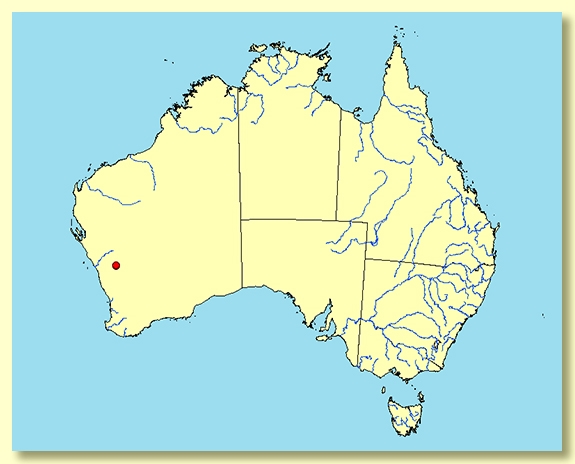Eucalyptus | Symphyomyrtus | Bisectae | Destitutae | Micrantherae | Bakerianae
Euclid - Online edition
Eucalyptus jutsonii subsp. kobela
Eucalyptus jutsonii subsp. kobela D.Nicolle & M.E.French, Nuytsia 17(1): 284-287 (2007).
T: Western Australia: Karara Station [sic - actually Lochada Station], north-east of Perenjori, [precise locality withheld for conservation purposes], 28 May 2006, M.E. French 1794 (holo: PERTH; iso: AD, CANB).
Mallee 3 to 6 m tall. Forming a lignotuber.
Bark rough to branches ca 3 cm diameter, coarsely fissured and stringy-fibrous, grey.
Branchlets lacking oil glands in the pith.
Juvenile growth (coppice or field seedlings to 50 cm): not seen.
Adult leaves alternate, petioles to 0.1–0.5 cm long; blade linear, 7–15 cm long, 0.1–0.3 cm wide, base tapering to petiole, margin entire, apex pointed, concolorous, glossy, dark green, thick, side-veins acute or obscure, reticulation moderate to dense or obscure, intramarginal vein not visible or incomplete, oil glands intersectional.
Inflorescence axillary unbranched, peduncles 0.2–0.4 cm long, buds 7, pedicellate (pedicels 0.1–0.2 cm long). Mature buds fusiform to ovoid (0.8–1 cm long, 0.3–0.4 cm wide), scar present (outer operculum shed early), inner operculum conical or weakly beaked (ca 0.5 cm long), stamens all inflexed, anthers cuboid or slightly wider than long, versatile, dorsifixed, dehiscing by short oblique slits, style long and straight, arising between three lobes on the ovary roof, stigma rounded to tapering, ovary roof with sutures passing radially through lobes, locules 3, the placentae each with 4 vertical rows of ovules. Flowers not seen.
Fruit pedicellate (pedicels 0.1–0.3 cm long), cupular-hemispherical, 0.3–0.5 cm long, 0.5–0.6 cm wide, disc level or descending obliquely, valves 3, weakly exserted or at rim level.
Seeds brown, 1.3–1.8 mm long, flattened-ovoid, dorsal surface with shallow or obscure reticulation, hilum ventral.
Cultivated seedlings (measured at node 10): (not grown by us, data after Nicolle & French (2007), see above): cotyledons Y-shaped (bisected); leaves sessile, linear, to 11 cm long, to 0.4 cm wide, dull, blue-green.
Flowering time not known.
Eucalyptus jutsonii is a mallee endemic to the arid zone of Western Australia and of very restricted distribution north of Kalgoorlie, from the Comet Vale area east to Carr Boyd Rock, with another disjunct population occurring north-east of Perenjori. It occurs on sandy sites, usually dunes with mallee scrub. The bark is rough on the stems and usually the branches, often as small as 3 cm diameter. The adult leaves are glossy green and strikingly linear and the buds axillary and bi-conic in shape.
There are two subspecies:
E. jutsonii subsp. jutsonii occurs north of Kalgoorlie and has adult leaves 0.3–0.7 cm wide, and fruit 0.4–0.8 cm long and 0.5–0.8 cm wide.
E. jutsonii subsp. kobela occurs only north-east of Perenjori, has adult leaves 0.1-0.3 cm wide, and fruit 0.3–0.5 cm long and 0.5–0.6 cm wide
Eucalyptus jutsonii belongs in Eucalyptus subgenus Symphyomyrtus section Bisectae subsection Destitutae because buds have two opercula, cotyledons are Y-shaped and branchlets lack oil glands in the pith. Within this subsection E. jutsonii is closely related to only three other species, E. micranthera (from near Esperance, Western Australia), E. bakeri (from northern New South Wales and southern Queensland) and E. mannensis (from central Australia to Shark Bay area of Western Australia), all of which have a peculiar three-lobed ovary roof in which the base of the style is inserted, and leaves with conspicuous intersectional oil glands.
Within its natural range E. jutsonii is distinguished from other mallee species by the combination of mallee habit, rough stems, dark green linear adult leaves, unusual ovary roof and versatile anthers.
Eucalyptus jutsonii: after John Thomas Jutson (1874–1959). From 1911–1918 John Jutson was a geologist with the Geological Survey of Western Australia.
subsp. kobela: from the Greek kobele meaning needle, referring to the adult leaves.






